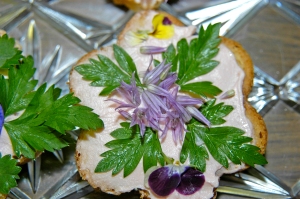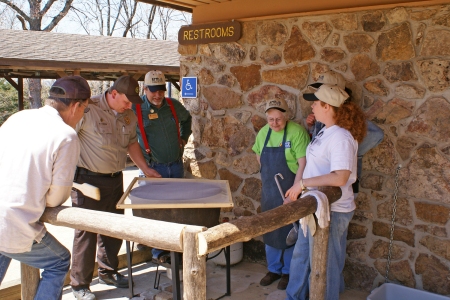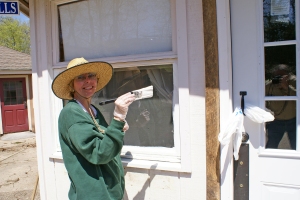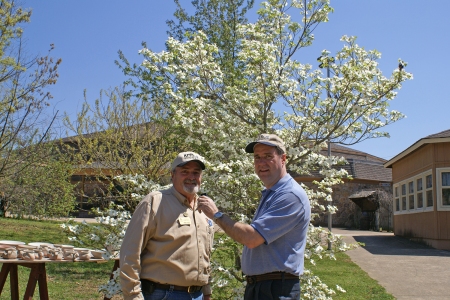Over the long history of Arkansas State Parks there have been a myriad of surprising delights and educational opportunities that cannot be found anywhere else. For example, the very first Lavish Herbal Feast occurred on April 22, 1989, at the Ozark Folk Center State Park in Mountain View, Arkansas. It was a collaborative production of the all-woman volunteer organization, The Committee of 100 for the Ozark Folk Center, herbal experts Jim Long and Billy Joe Tatum and the Heritage Herb Garden and the park staff. The meal began with a Sweet Woodruff May Punch reception hosted by the Herb Garden Committee of the Committee of 100. The feast featured five courses with live violin music by Maestro James Gambino. The dinner was the opening event of the third annual Heritage Herb Weekend.
The Lavish Herbal Feast in the spring and the autumnal Herb Harvest Sumptuous Supper are a part of the herbal traditions that set the Ozark Folk Center Arkansas State Parks apart from any other park system. Arkansas State Parks boast a nationally noted herb garden at the Ozark Folk Center that was funded by monies raised by The Committee of 100. The collaborative spirit that was planted in the garden by the Committee of 100 has grown to include the participation of the Ozark Folk Center volunteers, Arkansas Master Gardeners, the Mountain View Garden Club and the Ozark Chapter of the Herb Society of America, and a small army of individual friends. Many young people have completed community service hours working in the greenhouse and gardens while helping to prepare for the herb dinners and events.
Today, at the entrance of the Skillet Restaurant, pause to stroke and inhale the essential oil of the rosemary bushes and pinch a bay leaf from the towering tree in the native stone alcove. Once inside, be seated at oak tables in high back chairs to enjoy a meal in comfortable elegance. Only glass separates you from birds feathered in every hue; catch the flash of a pileated woodpecker and the antics of chipmunks and squirrels. Admire the homestead antiques that are displayed on the cornice; cast iron chandeliers suspended from exposed wooden beams, shine light on an evening meal. The Skillet’s hospitable wait staff serves great country cooking every day, during the season, between 7 a.m. and 8 p.m..
For future fun, foodies and herb enthusiasts might visit The Ozark Folk Center State Park and mark your calendars. Each spring and fall, preceding the Heritage Herb Spring Extravaganza and the Herb Harvest Fall Festival, The Skillet Restaurant becomes an epicurean destination. Fresh themes are explored at every event. The reception is comprised of live music, artful arrangements of flowers, multi-textured and scented leaves, herbal libations and tantalizing appetizers. Seasonal foods are selected for the menu with conscious consideration for the satisfaction of meat lovers and vegetarians. Fresh herbs and greens are harvested from the park’s Kitchen Garden. The Skillet is festooned, a special program is always included as a part of the evening and the appetite is whetted for more knowledge of herbs.
The next Lavish Herbal Feast is Thursday, April 29, 2010. The menu begins with a Summer Greek Salad followed by Tomato Bisque Soup with Dill, Herb of the Year 2010. There are three entrees from which to choose: Vegetables and Tempeh Au Gratin, Roast Leg of Lamb with Pistachio-Mint Pesto, Chicken with Amaretto Tarragon Sauce. The spring vegetables include New Potatoes with Dill and Lemon Zest and Fresh Snow Peas with Chervil. The grand finale is Tres Leche Cake served with Strawberries in Lemon Verbena Syrup.
Committee of 100 member Patricia French with cookbook authors Pat Crocker and Susan Belsinger have designed the dinner. Members of the Ozark Chapter of the Herb Society of America will assist the Committee of 100 with the reception. The Lavish Herbal Feast sells out every year. Reservations are required by April 21. The Herb Harvest Sumptuous Supper is Thursday, September 30, 2010. The reception begins at 6 p.m., with dinner at 6:30 both evenings. Visit The Ozark Folk Center State Park for further details or call (870) 269-3851.
Tina Marie Wilcox has been the head gardener and herbalist at the Ozark Folk Center’s Heritage Herb Garden in Mountain View, Arkansas since 1984. She tends the extensive gardens, plans and coordinates annual herbal events and workshops and facilitates the production of sale plants, seeds and herbal products for the park. She is a well-seasoned herbal educator and entertainer and co-author of the creative herbal home, which has been translated into Japanese and will be released in Japan in 2010.
Tina is currently collaborating with co-Author, Susan Belsinger, on articles for The Herb Companion, and Grit magazines. She writes a weekly herb and garden column entitled “Yarb Tales” for the Stone County Leader.
Tina is a member of the Herb Society of America, the American Botanical Council, and serves on the board of the International Herb Association.
Tina Marie Wilcox sings and plays guitar with a women’s trio known as The Herbin’ League. The trio performs traditional mountain folk music and an eclectic blend of favorite tunes with an emphasis on three-part harmony.
Tina’s philosophy is based upon experiencing the joy of the process, perpetrating no harm, and understanding life through play with plants and people.










 Posted by Arkansas State Parks
Posted by Arkansas State Parks 

























 Facebook
Facebook Twitter
Twitter YouTube
YouTube
